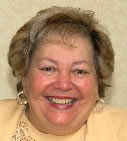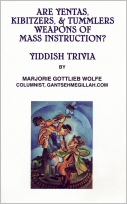  
|
Marjorie Gottlieb Wolfe

Syosset, New York
  
|

Choosing a wedding gown is aways a special time in a bride's life.
No matter what their taste is, they are sure to find an incredible creation.
In 2013, we hear of the "Bridezilla"--the style-fixated bride who has taken [wedding] fussiness to a new level.
Let's compare that to the late Molly Picon's experience. Molly was the petite, effervescent star of vaudeville, Broadway and the Yiddish theater. She starred in the Jerry Herman musical, "Milk and Honey" and has been dubbed "the Yiddish Helen Hayes" and "a bean-sized Bernhardt."
In 1919, Molly married Yonkel (Jacob) Kalich. They get their marriage license at City hall. Yonkel paid $2 for it. The ceremony took place in the room behind Mama's store. She wore a wedding dress Mama made from a "forhang" (curtain/drape) she acquired from the Arch Street Theater.
When the couple made their entrance, her dress was rolled up to her
knees so it shouldn't get dirty. and the veil was off. Grandma quickly pulled the veil over her face as Mama struggled to get her wedding gown down over her knees. Molly became Mrs. Jacob Kalich, with a thin golden wedding ring and a love-full heart and nothing has surpassed that shabby
little wedding in the back room of Mama's store.
Source: "Molly! An Autobiography By Molly Picon with Jean Bergantini
Grillo"
F-a-s-t forward to 1968, when Barbra Streisand played the part of Fanny Brice in "Funny Girl." Perhaps you remember how she enters the stage with a pillow stuffed under her bridal gown so that she appears "shvanger" (pregnant). Yes, she was the "knocked up" bride in "vays" (white).
Streisand said of her marriage to Elliot Gould, "I got married in a seersucker suit with a justice of the peace in Carson City, Nevada." (She and Gould divorced in 1971.)
However, when Barbra Streisand and James Brolin got married at
their Malibu home, she planned the whole event in two weeks, complete
with a flowing Donna Karan gown. Karan jetted in from Manhattan with
two assistants. The bride planned every detail with the care that goes
into a major production. Streisand said, "I realized later that I looked familiar to myself--like the character in Funny Girl.
There's an exhibit at the Museum of the Jewish People in Tel
Aviv titled, "Here Comes the Bride: Bridal Gowns Embroidering a Jewish
Story." The exhibition of 13 bridal dresses, one henna ceremonial gown
and one groom's outfit reflect styles and traditions of Jewish communities
in Yemen, Iraq, Turkey, Salonika, Spain, Poland, Germany, Morocco
and Algiers.
"There is nothing like it in the world," said Irit Admoni Perlman, director of the museum's Israel Friends Organization.
And, finally, aish.com carried a story titled, "The Holocaust Bride." It was written by Helen Zegerman Schwimmer and appeared in the Jewish Press. It is just so touching. Note: The Yiddish terms have been added to the piece.
This is a true story about a magnificent wedding gown MADE OF A WORN-OUT PARACHUTE.
Lilly Friedman is unable to remember "der nomen" (the name) of the woman who sewed the wedding gown she wore when she walked down the aisle over 60 years ago. This "bobe" (grandmother) of seven doesn't recall when she first told her "khosn" (fiance) that she had always dreamed of being married in a "vays kleyd" (white gown). He had his work cut out for him.
The "hoykh" (tall), lanky 21-year-old who had survived hunger, "krankayt" (disease) and "paynikung" (torture) now faced a different kind of challenge. How was he ever going to find such a dress in the Bergen Belsen Displaced Person's camp where they felt "dankbar") grateful for the clothes on their backs?
"Goryl" (fate) would intervene in the guise of a former German pilot who walked into the food distribution center where Ludwig worked. He was eager to make a trade for his "nishtik" (worthless) parachute. In exchange for two pounds of "kave" (coffee) and a couple of packs of cigarettes, Lilly would have her wedding gown.
For two weeks Miriam the seamstress under the curious "eygelekh" (eyes) of her fellow DPs, carefully fashioning the six parachute panels into a "poshet" (simple), long-sleeved gown with a rolled collar and a fitted waist that tied in the back with a bow. When the dress was completed, she sewed the leftover material into a matching shirt for the groom.
For Lilly, the dress symbolized the innocent, normal life she and her family had once led before the world descended into "mehugaas" (madness). Lilly and her siblings were raised in a Torah observant home in a small town in Zarica, Czechoslovakia, where her father was a Torah teacher, a "laytish" (respectable) man, well-liked by the young students he taught in nearby Irsheva.
He and his two sons were marked for extermination immediately upon arriving at Auschwitz. For Lilly and her sisters it was only their first stop on their long journey of persecution, which included Plashof, Neustadt, Gross Rosen, and finally, Bergen Belsen.
Four hundred people marched 15 miles in "der shney" (the snow) to the town of Celle on Jan. 27, 1946, to attend Lilly and Ludwig's wedding. The town synagogue, damaged and desecrated, had been lovingly renovated by the DPs with the meager materials available to them. When a Torah scroll arrive from England, they converted an old kitchen cabinet into a makeshift ark.
"My sisters and I lost everything--our parents, our two brothers, our homes. The most important thing was to build a new home." Six months later, Lilly's sister Ilona wore the dress when she married Max Traeger. After that came Cousin Rosie.
The question: "How many brides wore Lilly's dress?
Answer: "I stopped counting after 17," Lilly said.
With the camps experiencing the "grest" (largest) marriage rate in the world, Lilly's gown was in great demand.
In 1948, when Pres. Harry Truman finally permitted the 100,000 Jews who had been languishing in DP camps since the end of the war to emigrate, the gown accompanied Lilly across "der yam" (the ocean). Unable to part with her dress, it lay at the bottom of her "shloftsimer" (bedroom) closet FOR THE NEXT 50 YEARS. She said it was "not even good enough for a garage sale" and "she was happy when it found such a good home."
Home was the U. S. Holocaust Memorial Museum in Washington, D.C. When Lily's niece, a volunteer, told museum officials about her aunt's dress, they "teykef" (immediately) recognized its historical significance and displayed the gown in a specially designed showcase, guaranteed to preserve it for 500 years.
Lilly Friedman's dress had one more journey to make. Bergen Belsen, the museum, opened its doors on Oct. 28, 2007. The German government invited Lilly and her sisters to be their guests for the grand opening. They initially declined, but finally traveled to Hanover the following year with their children, their grandchildren and extended families to view the "umgeveyntlekh" (extraordinary) exhibit created for the wedding gown dress made from a parachute.
Lilly's family were eager to visit the synagogue. They found the building had been completely renovated and modernized. But when they pulled aside the handsome curtain they were astounded to find the holy ark, made from a kitchen cabinet, had remained untouched as a testament to the profound faith of the survivors. As Lilly stood on the bimah once again, she beckoned to her granddaughter, Jackie, to stand beside her where he was once a "kale" (bride). "It was an emotional trip. We cried a lot."
Two weeks later, the woman who had once stood trembling before the selective eyes of the infamous Dr. Josef Mengele returned home and witnessed the marriage of her granddaughter.
The three Lax sisters--Lilly, Ilona and Eve, who together survived
Auschwitz, a forced labor camp, a death march and Bergen Bergen--
have remained close and today live within walking distance of each other
in Brooklyn. As mere teenagers, they managed to outwit and outlive
a monstrous killing machine, then went on to marry, have children,
grandchildren and "ureyniklekh" (great-grandchildren)--and were
ultimately honored by the country that had earmarked them for extinction.
-----------------------------------------------------------
MARJORIE WOLFE loves Tom Carey's definition of "Garter":
"Bit of lingerie you are supposed to remove from your wife's leg during
the reception and toss, per her instructions, to her best friend's
long-time cold-footed beau. Her plans will be dashed when said beau is in the bathroom during the ceremony, allowing the garter to be snagged by
your annoying 12-year-old nephew, who will pester the bride's best friend
for the rest of the night saying, ‘Hey, baby, when's the honeymoon?'"
("The Marriage Dictionary")
| A | B | C | D | E | F | G | H | I | J | K | L | M |
| N | O | P | Q | R | S | T | U | V | W | Y | Z |


| Yiddish
Stuff Jewish Humor Schmooze News More Majorie Wolfe |
Principle Jewish Stories All Things Jewish Jewish Communities of the World |